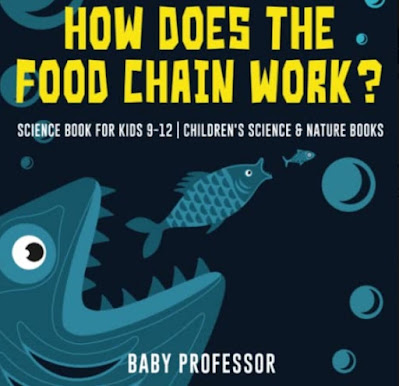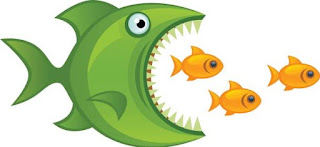Disclosure:
Affiliate links to Amazon
are included in this post.
Essential Concepts and Vocabulary
Even though it is possible to play The Food Chain Game without any prior knowledge, children will gain more from the
experience if they understand the following concepts and vocabulary words:
- predator, prey
- food, energy, calories
- food chain, food web
- herbivore, carnivore, omnivore
- scavenger, decomposer
- producer, consumer
- ecosystem
For the purposes of this game, we'll be
using herbivores, omnivores,
and carnivores to keep things simple. Feel free to modify
the game to meet the needs of the curriculum you use.

Materials Needed
Very few materials are needed to play The Food Chain Game and can be
purchased inexpensively online or in a dollar store.
- lots and lots and lots of popped popcorn
- one Ziploc bag per child, quart size or larger
- roll of masking tape (optional)
- Sharpie marker for labeling
Getting Ready to Play
Before playing The Food Chain Game with your students, there is some
prep work you will need to do ahead of time.
- Find a large grassy area for your children to run and play. Scatter the popcorn all over it. (You can save some of the popcorn for a fun snack when you're done playing!)
- Draw a line across each bag and label them as shown below. 1/3 of your bags will be labeled herbivore. 1/3 of your bags will be labeled carnivore, and 1/3 of your bags will be labeled omnivore.
- Give your children a labeled bag. This bag will let them know if they are a carnivore, an herbivore, or an herbivore.

Important Note: When drawing the lines on the bags, there are no specific
measurements to follow because every animal requires and eats different
amounts of food in real life. Since carnivores require the most amount of
food, draw the carnivore lines near the top of the bags. Draw the
herbivore lines near the bottom of the bags and the omnivore lines
somewhere in the middle. Believe it or not, not having precise
measurements will actually help in The Food Chain Game!
Rules of the Game
When you say GO!, the children will race to the grassy area to gather as
much popcorn as possible. This popcorn represents the food the animals need
to consume to survive as follows:
- Herbivores only eat plants, seeds, nuts, berries, bark, etc. Therefore, they can only collect popcorn from the grass.
- Omnivores eat both plants and other animals. They can collect popcorn from the ground AND from the herbivores.
- Carnivores are meat eaters. Therefore, they collect popcorn from herbivores and omnivores... NEVER from the ground.

How to Play
- Playing The Food Chain Game is similar to playing tag. When a child is tagged, they have been 'eaten' and are out.
- When a child has been tagged, they need to add their popcorn to the other child's bag and give their empty bag to you.
- Once a child has filled their bag up to the line, they can no longer gather popcorn. They now need to avoid being tagged by the others.
- If an omnivore or carnivore wants to 'eat' another animal, the two children stop and compare the lines on their bags. Whoever has the bag with the lower line gets 'eaten' and has to surrender their popcorn to the other. Any extra popcorn above the line gets rescattered on the ground.
- The game ends when there is either no more popcorn on the ground or when the carnivores have filled their bags to the line.
- If time allows, play this game again a couple of times to give everyone the feeling of being an herbivore and carnivore.
Follow Up Discussion
After playing The Food Chain Game, talk briefly about what happened
while the children were playing. How did it feel to be an herbivore? How hard was it for
them to survive? How did it feel to be a carnivore? How hard was it for them
to survive? In many games, the herbivores are the first ones eliminated from
playing, then the omnivores. How did the game change when there were only
carnivores left? Did the carnivores start tagging each other? What other
patterns did your children see while playing?
Related Children's Book
Are you looking for a related children's book to read with your children
before or after playing The Food Chain Game? If so,
How Does the Food Chain Work by Baby Professor might be a good option
for you. (PS. Don't let the name Baby Professor deter you from this book.
How Does the Food Chain Work was written for 9 to 12-year-olds... not
babies!)
🍎 Title:
How Does the Food Chain Work?
🍎 Author: Baby Professor
🍎 Publisher: Baby Professor
🍎 Year: 2017
🍎 Pages: 64
Did you enjoy this post about The Food Chain Game? If so, check out
these blog posts for more science books and activities:
- Book: A Dinosaur Made Me Spill: A Water Cycle Adventure by Carla Mae Jansen
- STEM: What Happens When You Plant Birdseed?
- Book List: 10+ Children's Books about Animal Poop
- Book +STEM Craft: Over and Under the Snow by Kate Messner
- Book + STEM Activity: Pumpkin Life Cycle STEM Activity ('Pumpkin Jack')
- STEM Activity: How to Grow Radishes from Scraps




This is great, Kelly. Inexpensive and fun!!
ReplyDelete